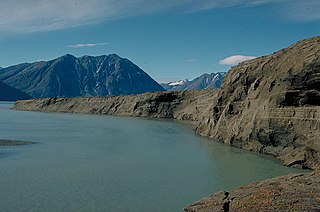
Knud Johan Victor Rasmussen was a Greenlandic–Danish polar explorer and anthropologist. He has been called the "father of Eskimology" and was the first European to cross the Northwest Passage via dog sled. He remains well known in Greenland, Denmark and among Canadian Inuit.

Ilulissat, formerly Jakobshavn or Jacobshaven, is the municipal seat and largest town of the Avannaata municipality in western Greenland, located approximately 350 km (220 mi) north of the Arctic Circle. With the population of 4,541 as of 2013, it is the third-largest city in Greenland, after Nuuk and Sisimiut. The city is home to almost as many sled-dogs as people.

Ludvig Mylius-Erichsen was a Danish author, ethnologist, and explorer, from Ringkøbing. He was most notably an explorer of Greenland.

Johan Peter Koch was a Danish captain and explorer of the Arctic dependencies of Denmark, born at Vestenskov.

Independence II was a Paleo-Eskimo culture that flourished in northern and northeastern Greenland from around 700 to 80 BC, north and south of the Independence Fjord. The Independence II culture existed in roughly the same areas of Greenland as the Independence I culture, which became extinct six centuries before the beginning of Independence II.

Independence Fjord or Independence Sound is a large fjord or sound in the eastern part of northern Greenland. It is about 200 km (120 mi) long and up to 30 km (19 mi) wide. Its mouth, opening to the Wandel Sea of the Arctic Ocean is located at 82°15′N21°54′W.
Deltaterrasserne is a pre-Inuit occupation archaeological site located near the head of Jørgen Brønlund Fjord on the Peary Land peninsula in northern Greenland. It is one of the largest archaeological sites in Peary Land, and was discovered in September 1948 by the Danish explorer and archaeologist Eigil Knuth during the second summer of the Danish Pearyland Expedition. Occupied during the period of 4000–3700 B.P., the site contains features of Independence I and Independence II culture cultures.

Eivind Astrup was a Norwegian explorer and writer. Astrup participated in Robert Peary's expedition to Greenland in 1891–92 and mapped northern Greenland. In the follow-up Greenland expedition by Peary during 1893–94 he explored and mapped Melville Bay on the north-west coast of Greenland. Among his works is Blandt Nordpolens Naboer from 1895. He was awarded the Knight of the Order of St. Olav in 1892.

King Frederick VIII Land is a major geographic division of northeastern Greenland. It extends above the Arctic Circle from 76°N to 81°N in a N/S direction along the coast of the Greenland Sea.
The Mørkefjord expedition of 1938–1939 was sent out by Alf Trolle, Ebbe Munck, and Eigil Knuth in order to continue the work of the Denmark Expedition. It was an exploratory expedition to Northeast Greenland led by Eigil Knuth and had been planned to last from 1938 to 1939. It was affected by the outbreak of World War II.

The Denmark expedition, also known as Denmark Expedition to Greenland's Northeast Coast, and as the Danmark Expedition after the ship, was an expedition to the northeast of Greenland in 1906–1908.

Niels Peter Høeg Hagen, was a Danish military officer, polar explorer and cartographer. He participated in the ill-fated Denmark expedition to NE Greenland in 1906.

Henson Glacier, is one of the major glaciers in northern Greenland.



















